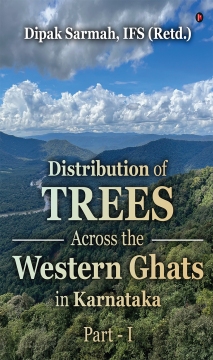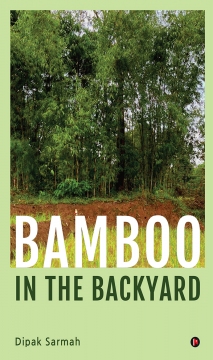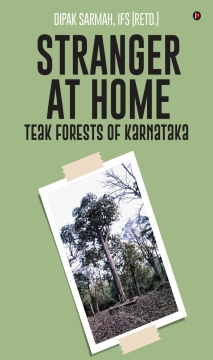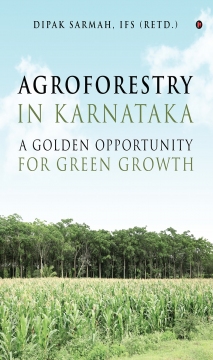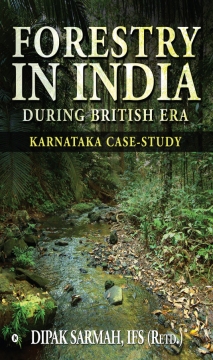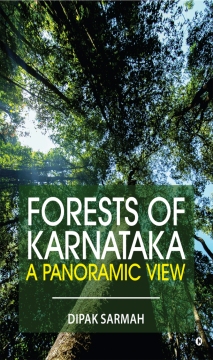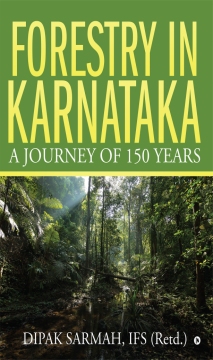
- Discover books
- For Writers
-
For Writers
-
Indie Author Championship
-
Challenges
Writing Contests
- Get Started

"It was a wonderful experience interacting with you and appreciate the way you have planned and executed the whole publication process within the agreed timelines.”
Subrat SaurabhAuthor of Kuch Woh Pal -
-
-
IN
- India
- Singapore
- Malaysia
- 0
DIPAK SARMAH, IFS (Retd.)
Shri Dipak Sarmah, a retired Indian Forest Service (1977) officer of the Karnataka cadre, started his career in the Western Ghats, serving in the region for more than a decade. He also served in the Government of India as Deputy Adviser, Planning Commission and as Deputy Inspector General of Forests, Forest Policy, MoEF (1991-1995). Later, he served in a number of positions in the Government of Karnataka including Secretary (Forest), PCCF (Wildlife) & Chief Wildlife Warden, superannuating in December 2013 as PCCF (Head of Forest Force). Post retirement, Shri Sarmah has been assisting the KarnaRead More...
Shri Dipak Sarmah, a retired Indian Forest Service (1977) officer of the Karnataka cadre, started his career in the Western Ghats, serving in the region for more than a decade. He also served in the Government of India as Deputy Adviser, Planning Commission and as Deputy Inspector General of Forests, Forest Policy, MoEF (1991-1995). Later, he served in a number of positions in the Government of Karnataka including Secretary (Forest), PCCF (Wildlife) & Chief Wildlife Warden, superannuating in December 2013 as PCCF (Head of Forest Force). Post retirement, Shri Sarmah has been assisting the Karnataka Forest Department in the preparation of a number of documents such as Working Plans, Evaluation Reports, Cadre Review Report, Training Action Plan, etc. He has also assisted the Environmental Management and Policy Research Institute (EMPRI), Bangalore in compiling the State of Environment Report (SoER-2015) as chief editor. Shri Sarmah is the author of a number of books, namely, ‘Status of Forests of Karnataka’, ‘Forestry in Karnataka - A Journey of 150 Years’, ‘Forests of Karnataka – A Panoramic View’, ‘Wildlife Management in Karnataka – A Forester’s Perspective’, ‘Forestry in India during British Era – Karnataka Case-study’, and ‘Agroforestry in Karnataka – A Golden Opportunity for Green Growth’. In 2011, Shri Dipak Sarmah was nominated by the Hon’ble Supreme Court of India to the Monitoring Committee to supervise mining operations and sale of iron ore in Karnataka. He continues to serve as the Chairman of the Committee till date. He is currently the President of the ‘Institution of Agroforestry Farmers and Technologists ® (IAFT)’, Bengaluru, a non-government forum to promote agroforestry.
Read Less...Crop your profile image

DISTRIBUTION OF TREES ACROSS THE WESTERN GHATS IN KARNATAKA
Books by DIPAK SARMAH, IFS (Retd.)
The book, ‘Distribution of trees across the Western Ghats in Karnataka’, provides an analytical overview of how trees and other plants are distributed across various forests of the Western Ghats region in the state of Karnataka in India. The analysis is based on feedback provided by field functionaries of the Karnataka Forest Department (KFD) in pursuance of a project initiated by KFD in collaboration with the Karnataka State Remote Sensing Applications Ce
The book, ‘Distribution of trees across the Western Ghats in Karnataka’, provides an analytical overview of how trees and other plants are distributed across various forests of the Western Ghats region in the state of Karnataka in India. The analysis is based on feedback provided by field functionaries of the Karnataka Forest Department (KFD) in pursuance of a project initiated by KFD in collaboration with the Karnataka State Remote Sensing Applications Centre (KSRSAC), Bengaluru, to study various aspects of the state’s forests. Given the enormity of the data regarding trees and other plants adorning the forests of the entire state, the analysis in the present book is limited to the western half of the state’s Western Ghats region comprising the five districts of Belagavi, Uttara Kannada, Udupi, Dakshina Kannada and Kodagu. Range-wise segregation of the data has thrown light on various attributes such as forest types, tree distribution, tree association, tree dominance, tree preponderance, etc. in each forest range. Comparative analysis of such information for a cluster of ranges enables understanding of how these attributes change across a larger landscape such as a forest division or a forest circle. Analysis of the data has also provided information about the extent of fragmentation of natural forests due to plantations. Such information can be quite useful in rehabilitating monoculture patches back to natural forest.
FORESTS OF KARNATAKA - WHY AND HOW OF WHERE THEY ARE
Books by Dipak Sarmah
The book, ‘FORESTS OF KARNATAKA-WHY AND HOW OF WHERE THEY ARE,’ attempts at understanding the diverse forests of Karnataka, their current status, and the primary factors that led to their transformation from their pristine (original and un-spoilt) states to the present states. Although formation of different types of forest depends fundamentally upon the general climatic and soil-related factors which vary from place to place, the present conditions of the
The book, ‘FORESTS OF KARNATAKA-WHY AND HOW OF WHERE THEY ARE,’ attempts at understanding the diverse forests of Karnataka, their current status, and the primary factors that led to their transformation from their pristine (original and un-spoilt) states to the present states. Although formation of different types of forest depends fundamentally upon the general climatic and soil-related factors which vary from place to place, the present conditions of the forests are to a considerable extent reflective of the treatments meted out to them over the centuries. Past treatments of the forests include past forest management practices such as forest reservation, logging, clear-felling, raising plantations, forest protection, etc. as well as other biotic factors such as shifting cultivation, expansion of agriculture, heavy withdrawals of biomass, introduction of plantation crops, recurring fires, over-grazing, encroachments, etc. As a matter of fact, we now have different types of forest in different parts of the state depending upon the nature and intensity of the past interventions. The book while analysing various factors that resulted in degradation of a vast majority of the state’s forests has also suggested ways and means of how the existing forests can be protected from further degradation, enabling them to recover and rejuvenate.
BAMBOO IN THE BACKYARD
Books by DIPAK SARMAH
Bamboo is one of the three most important and well-distributed naturally occurring plant species of Karnataka; the other two species are teak (Tectona grandis L.f.) and sandal (Santalum album L.). While bamboo is fairly abundant in the deciduous forests of the Western Ghats region, it can also be found in interior Karnataka as well as in the Eastern Plains. However, large-scale utilization of the state’s enormous natural bamboo resources is not feasible in v
Bamboo is one of the three most important and well-distributed naturally occurring plant species of Karnataka; the other two species are teak (Tectona grandis L.f.) and sandal (Santalum album L.). While bamboo is fairly abundant in the deciduous forests of the Western Ghats region, it can also be found in interior Karnataka as well as in the Eastern Plains. However, large-scale utilization of the state’s enormous natural bamboo resources is not feasible in view of certain issues related to policy and management of the forests.
In light of the restricted availability of bamboo from the public forests, growing bamboo under agroforestry and farm forestry to meet the demands of people and industries assumes significance. The book, Bamboo in the Backyard, attempts at providing an overview of the bamboo-bearing forests of Karnataka, their past working, and present status. As its title suggests, the book underscores the need to bring bamboo closer to the people. In recent years, agroforestry, farm forestry and dry-land horticulture have made tremendous strides in Karnataka. Adding bamboo to the list of tree species that are being planted by farmers will add to the plant diversity in their farmlands and aid in enhancing the greenery of the agrarian landscape. Besides supporting and complementing agricultural operations, bamboo can contribute significantly to the farmers’ overall income and general welfare.
Down, but Not Out - Sandal in Karnataka
Books by Dipak Sarmah, IFS (Retd.)
Blessed with extensive tracts of natural forest harboring the sandal tree (Santalum album L.), the Indian state of Karnataka was a leading producer of sandalwood, the most valuable product of the tropical forest. However, due to rampant smuggling during the last three-four decades, Karnataka’s sandalwood production slipped to abysmally low levels, with hardly any mature sandal tree being left in the forests. What, however, is providential about the sa
Blessed with extensive tracts of natural forest harboring the sandal tree (Santalum album L.), the Indian state of Karnataka was a leading producer of sandalwood, the most valuable product of the tropical forest. However, due to rampant smuggling during the last three-four decades, Karnataka’s sandalwood production slipped to abysmally low levels, with hardly any mature sandal tree being left in the forests. What, however, is providential about the sandal is its resilience to fight for survival in the face of hostile situations. Because of this resilience, sandal has been able not only to survive in areas where it occurred naturally but also to surface in areas where it was not known to have existed in the past. This extraordinary ability of sandal to survive, adjust and propagate against heavy odds provides a beacon of hope that it is still possible to restore the lost glory of sandal in Karnataka’s forests. The book, ‘Down, but Not Out – Sandal in Karnataka’, attempts at sharing some information about the extensive sandal-bearing forests that existed throughout the length and breadth of Karnataka and how they responded to management interventions during the past two hundred years. It also dwells upon the challenges associated with the management of sandal in the context of its rapidly dwindling population and suggests ways and means to re-establish and replenish its depleted stock, ensuring that the new crop of sandal does not face the same fate as the old crop did in the past.
Stranger at Home - Teak Forests of Karnataka
Books by Dipak Sarmah, IFS (Retd.)
Peninsular India is one among the few regions of the world harboring natural teak forests. Karnataka is one of the states in the region that was blessed with extensive teak forests. Due to centuries of heavy exploitation for the prized wood and large-scale artificial introduction of teak since more than a century, the pristine teak forests have shrunk rapidly, being now confined only to a few pockets, mostly in the protected areas. Natural teak has virtually b
Peninsular India is one among the few regions of the world harboring natural teak forests. Karnataka is one of the states in the region that was blessed with extensive teak forests. Due to centuries of heavy exploitation for the prized wood and large-scale artificial introduction of teak since more than a century, the pristine teak forests have shrunk rapidly, being now confined only to a few pockets, mostly in the protected areas. Natural teak has virtually become an endangered species. The book, Stranger at Home – Teak Forests of Karnataka, attempts at sharing some information about the extensive natural teak forests that existed in Karnataka in the distant past. It also dwells upon the history of the development of teak plantations in the state. For various reasons including policy changes, court directives, lack of adequate funds, manpower, etc., management of these plantations has been a challenging task. The impact of monoculture on the biodiversity of the natural forest had also come in for sharper scrutiny and severe criticism. All these developments have somewhat slowed down the activities related to the management of the plantations, at times bordering on inaction. The book discusses various aspects and challenges associated with the management of teak forests and plantations, suggesting ways and means to forge ahead in the context of overall forest conservation with a special focus on biodiversity conservation.
FORESTS AND TREES OF KARNATAKA
Books by DIPAK SARMAH, IFS (Retd.)
The book Forests and Trees of Karnataka - A Journey in Time through Buchanan's Eyes attempts at providing a pen picture of the forests and trees of Karnataka as seen by Dr. Francis Buchanan during his journey undertaken in 1800 and 1801. As Buchanan’s narrations contained in his three-volume journal ‘A Journey from Madras through the Countries of Mysore, Canara and Malabar (1807)’ cover a wide range of subjects, his observations spec
The book Forests and Trees of Karnataka - A Journey in Time through Buchanan's Eyes attempts at providing a pen picture of the forests and trees of Karnataka as seen by Dr. Francis Buchanan during his journey undertaken in 1800 and 1801. As Buchanan’s narrations contained in his three-volume journal ‘A Journey from Madras through the Countries of Mysore, Canara and Malabar (1807)’ cover a wide range of subjects, his observations specifically on trees and other plants have been culled out with a view to visualizing the forest scenario of Karnataka more than 200 years ago. The book also highlights the important role trees were assigned in the distant past to complement agricultural operations and industrial activities leading to economic development and general welfare. Buchanan in his writings had underscored the ingenious ways through which the farmer, with the help of trees and other plants, conserved water, increased soil organic content and improved soil fertility. In fact there was an intrinsic relationship between water, agricultural crops, and the sylvan surrounding. Among the messages which Buchanan’s writings convey, the most pertinent one for the present times is perhaps that of the ancient wisdom of the farmer that the surest way to keep the earth cool is to keep it green.
DRY DECIDUOUS FORESTS OF KARNATAKA – ADDING YEARS TO THEIR LIFE, AND TO OURS
Books by DIPAK SARMAH, IFS (Retd.)
Dry Deciduous Forests of Karnataka – Adding Years to Their Life, and to Ours attempts at highlighting various aspects of the dry deciduous forests which once covered large parts of the state of Karnataka and which now occur only in a few, scattered pockets, having been almost entirely wiped out from two vast regions covering three-fourths of the state, namely, interior Karnataka and the Eastern Plains. Although not as imposing as the moist deci
Dry Deciduous Forests of Karnataka – Adding Years to Their Life, and to Ours attempts at highlighting various aspects of the dry deciduous forests which once covered large parts of the state of Karnataka and which now occur only in a few, scattered pockets, having been almost entirely wiped out from two vast regions covering three-fourths of the state, namely, interior Karnataka and the Eastern Plains. Although not as imposing as the moist deciduous, semi-evergreen and evergreen forests that are met with in the western part of the state, the dry deciduous forests have high ecological value in terms of biodiversity, soil and water conservation, climate moderation, medicinal properties, protection of agricultural land, etc. Although now restricted in patches dispersed over an almost limitless landscape, these forests have tremendous impact on the surrounding environment. More importantly, these are the last vestiges of natural vegetation in an expansive, open and parched region where the ominous signs of desertification are already perceptible. Conservation and development of these forests, by any means and before it is too late, is of utmost importance for the overall protection and amelioration of the surrounding environment of the state. An attempt has been made in the book in analyzing the various factors that were responsible for pushing these forests to their present dismal state, and in offering a few suggestions regarding restoration and rejuvenation of the vanishing forests.
AGROFORESTRY IN KARNATAKA – A GOLDEN OPPORTUNITY FOR GREEN GROWTH
Books by DIPAK SARMAH, IFS (Retd.)
Agroforestry in Karnataka – A Golden Opportunity for Green Growth highlights various aspects of agroforestry – a system of introduction, or rather reintroduction, of trees in and around agricultural lands in order to restore the ancient, organic relationship that existed between forest and agriculture. The book traces the evolution of agroforestry in the state of Karnataka in India and recounts the strides that have been made in this direc
Agroforestry in Karnataka – A Golden Opportunity for Green Growth highlights various aspects of agroforestry – a system of introduction, or rather reintroduction, of trees in and around agricultural lands in order to restore the ancient, organic relationship that existed between forest and agriculture. The book traces the evolution of agroforestry in the state of Karnataka in India and recounts the strides that have been made in this direction in the recent years. It dwells upon the multifarious beneficial effects of agroforestry on forest conservation, soil and water conservation, and development of agriculture, horticulture, sericulture, animal husbandry, apiculture, etc. Although agroforestry is seen as a very pragmatic step to increase the forest or tree cover, its benefits go far beyond: it has the potential of transforming the entire rural/agrarian landscape in terms of economic, ecological and environmental development. It is also likely to be the most befitting response to the challenges posed by climate change. It is difficult to visualize a climate-smart agricultural system without trees having been accorded a complementary but important role in it. In the coming days, agroforestry may hold the key to an overarching development in the agricultural sector, more particularly in the vast and expanding parched regions, where signs of desertification, drought, poverty, hunger and death are becoming increasingly ominous.
FORESTRY IN INDIA DURING BRITISH ERA
Books by DIPAK SARMAH, IFS (Retd.)
Forestry in India during British Era traces the history of the evolution of scientific forestry in India during the British era (1800-1947). A special emphasis of the narration is on the State of Karnataka, which was under British domination partly directly through the Bombay and Madras Presidencies and somewhat indirectly through the Princely States of Mysore, Hyderabad, Sandur and a few others.
Besides describing the developments of forestry tog
Forestry in India during British Era traces the history of the evolution of scientific forestry in India during the British era (1800-1947). A special emphasis of the narration is on the State of Karnataka, which was under British domination partly directly through the Bombay and Madras Presidencies and somewhat indirectly through the Princely States of Mysore, Hyderabad, Sandur and a few others.
Besides describing the developments of forestry together with the circumstances that led to these developments, the book assesses their long-term impact on the forests as we see them today. It provides a graphic account of the birth of the forest departments and the hurdles they had to face in their bid to be effective in guarding the forests – the last vestiges of nature – from the verge of imminent extinction.
Forestry in India during British Era has critically examined some of the important causes that led to forest destruction, such as the large-scale expansion of agriculture, the heavy withdrawal of biomass, the extensive shifting cultivation in the Ghat forests, etc. It also objectively analyses what the forestry scenario would have been like today had the process of forest reservation not been zealously initiated about 150 years ago and if these forests hadn’t been steadfastly and arduously guarded by the forest departments throughout these years.
Wildlife Management in Karnataka
Books by DIPAK SARMAH, IFS (Retd.)
The book traces the evolution of wildlife management in the state of Karnataka in India. It provides glimpses of how the concept of wildlife management grew as an offshoot of forest management and evolved into an overarching policy initiative. It presents a chronological account of the development of national wildlife policies, plans and strategies and their impact on the wildlife management in the states. The book highlights the events that unfolded as produc
The book traces the evolution of wildlife management in the state of Karnataka in India. It provides glimpses of how the concept of wildlife management grew as an offshoot of forest management and evolved into an overarching policy initiative. It presents a chronological account of the development of national wildlife policies, plans and strategies and their impact on the wildlife management in the states. The book highlights the events that unfolded as production-centric management gave way to wildlife-centric management in certain designated forest areas, known as Protected Areas. It outlines a significant aspect of wildlife conservation in the state—namely, the immense contribution of a ‘conservation-oriented forest management’ approach that the Forest Department has adopted since the 1980s for management of all types of forests in the state. The challenges faced by wildlife officers in handling matters related to man-animal conflict, rehabilitation of people from protected areas and forest protection with possible suggestions to resolve them are related. The need to take cautious steps in strengthening wildlife tourism and research is emphasized. The book also examines the relative merits of the forest laws and wildlife laws, and calls for wider application of the wildlife laws to protect the vanishing forests, especially in the eastern plains.
Forests of Karnataka - A Panoramic View
Books by Dipak Sarmah
The book provides an overview of the various types of forests occurring in the Indian state of Karnataka. Some of the most magnificent tropical forests of the Western Ghats are found here, including evergreen, semi-evergreen, moist deciduous, dry deciduous, thorn, shola, swamp and mangrove. Although scattered information about these forests is available, such information for the whole state is not available in the form of a comprehensive document. The book, wh
The book provides an overview of the various types of forests occurring in the Indian state of Karnataka. Some of the most magnificent tropical forests of the Western Ghats are found here, including evergreen, semi-evergreen, moist deciduous, dry deciduous, thorn, shola, swamp and mangrove. Although scattered information about these forests is available, such information for the whole state is not available in the form of a comprehensive document. The book, while providing district-wise information about Karnataka’s forests, also dwells upon the interplay of different factors that have led to the formation and transformation of these forests. It critically analyzes the salient features about tropical forests, their past management and present status; this is relevant not only to Karnataka’s forests but also to the tropical forests of peninsular India, in particular, and Indian forests in general.
The book provides a brief description about some 325 tree species—some endemic to the Western Ghats, some stretching from Australia to Africa and many pan-India—touching upon their ecology, habitat, field characteristics, tips for identification and utilization, including traditional medicinal uses. These trees represent a very wide spectrum of the trees from tropical forests.
Forestry in Karnataka – a Journey of 150 Years
Books by Dipak Sarmah, IFS (Retd.)
The book traces the history of forestry since the middle of the 19th century in the erstwhile territorial units that constitute the present state of Karnataka, in India. It provides glimpses of the forest policy and management of the British Indian government which had laid the foundations of scientific forestry in the Indian subcontinent. A chronological account of the development of national forest policies, plans, and strategies in post-independe
The book traces the history of forestry since the middle of the 19th century in the erstwhile territorial units that constitute the present state of Karnataka, in India. It provides glimpses of the forest policy and management of the British Indian government which had laid the foundations of scientific forestry in the Indian subcontinent. A chronological account of the development of national forest policies, plans, and strategies in post-independent India has also been given in the context of their impact on forest management in the states. The book dwells comprehensively on multifarious aspects of forestry including the challenges faced by a forester in a situation of increasing demand and shrinking forest. It highlights the strengths and weaknesses of the forest administration and recommends strategies to protect the remaining natural forest and to increase the tree cover everywhere to effectively confront the specter of environmental catastrophes facing the planet earth. The book has brought out the inseparable and intrinsic relationship of mutual interdependence between forest and water – two of the most important natural resources on which the future of mankind depends, and calls for urgent action. With detailed data, analysis, and inferences derived with an open mind, the book forms a reference document for the present and future foresters. Problems of the forestry sector in the developing world are similar. Although the book focuses on the forestry scenario in Karnataka, lessons learned and strategies recommended for forest conservation are relevant across a larger landscape, with similar challenges and problems.

Are you sure you want to close this?
You might lose all unsaved changes.
Select from one of our global stores to continue
 India
India
 Singapore
Singapore
 Malaysia
Malaysia
Warning Message
The items in your Cart will be deleted, click ok to proceed.











